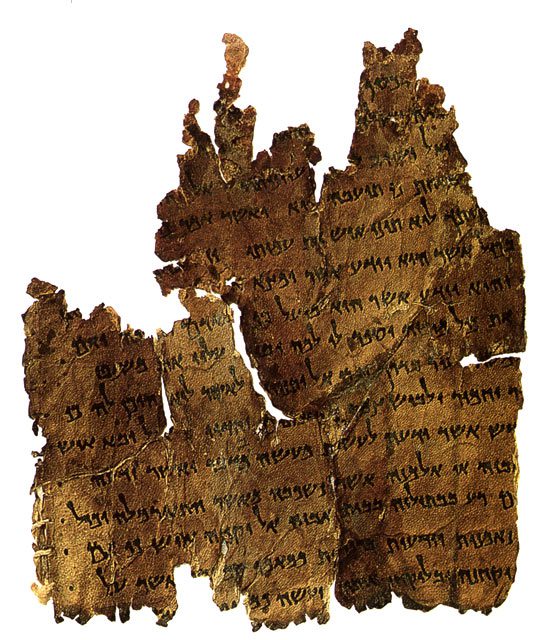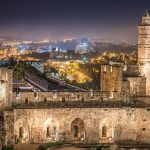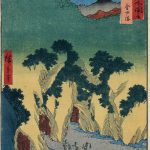
The Dead Sea Scrolls, discovered in the Qumran caves near the Dead Sea in 1947, are considered one of the most significant archaeological finds of the 20th century. They contain some of the oldest known manuscripts of the Hebrew Bible, along with a range of religious, legal, and apocalyptic texts. But among the ancient writings, scholars have noticed something unusual—mysterious symbols and markings that do not fit within any known language or script. These strange symbols remain one of the biggest unresolved mysteries surrounding the scrolls.
Unlike the well-preserved biblical passages, these symbols do not appear to form coherent words or sentences. Some look like abstract shapes, while others resemble coded sequences, tally marks, or unknown letters. They are found in various scrolls, sometimes in the margins and sometimes embedded within the text itself. Their purpose remains debated—were they used for religious rituals, hidden messages, or merely scribal annotations?
The mystery deepens when considering that similar markings are not commonly found in other ancient Jewish manuscripts from the same period. Some scholars suggest that these symbols were unique to the Qumran community, possibly indicating a secret code or a lost writing system. Others believe they could be linked to mystical traditions, with meanings tied to esoteric knowledge that was only meant for a select group of initiates.
In this article, we will explore the discovery of the Dead Sea Scrolls, examine the different types of symbols found within them, and discuss the leading theories about their meaning. From ancient cryptography to religious significance, we will delve into the fascinating enigma of these strange markings and what they might reveal about the Qumran sect that created the scrolls.
The Discovery of the Dead Sea Scrolls
In the spring of 1947, a young Bedouin shepherd named Muhammad edh-Dhib was searching for a lost goat in the desert near the Dead Sea. When he threw a rock into a cave opening, he heard the sound of breaking pottery. Upon investigating, he discovered large clay jars containing ancient scrolls, some wrapped in linen. This accidental discovery set off one of the most remarkable archaeological hunts in history.
Over the next decade, archaeologists and local treasure hunters uncovered fragments of nearly 1,000 manuscripts spread across 11 caves near the ruins of Qumran. The scrolls, written on parchment and papyrus, had been remarkably preserved due to the dry desert climate. They date from roughly 250 BCE to 68 CE, making them over 2,000 years old. Many of the texts are written in Hebrew, with some in Aramaic and a few in Greek.
The contents of the scrolls vary widely. About 40% contain texts from the Hebrew Bible (Old Testament), often in versions slightly different from the ones that survived in later Jewish traditions. Another 30% consist of sectarian writings—unique texts that describe the beliefs, laws, and practices of the community that wrote them. The remaining 30% include apocryphal and pseudepigraphal works, some of which were unknown before the discovery.
The presence of strange symbols scattered throughout some of these manuscripts has puzzled scholars for decades. Unlike the neatly copied biblical texts, these symbols appear sporadically, often in non-biblical writings. Some scrolls contain geometric patterns, odd punctuation-like marks, or cryptic sequences that seem unrelated to the surrounding text. What were these symbols used for, and why were they included?
Unusual Symbols Found in the Scrolls
Throughout the Dead Sea Scrolls, researchers have identified several different types of unusual markings. These range from simple lines and dots to more complex symbols that do not match any known ancient script. In some cases, the symbols appear to have been intentionally added to the manuscripts, while in others, they seem to be part of the original writing.
One of the most commonly found symbols is a series of dots arranged in seemingly random patterns. These dots do not correspond to traditional Hebrew punctuation or vocalization marks, leading some scholars to suggest they may have served as a form of coded notation. Another frequently appearing symbol resembles a small “X” or cross-like mark, which is found in several different scrolls without an obvious meaning.
Additionally, certain scrolls contain what look like tally marks or numbering systems that do not match known methods of counting from the period. Some of these markings could indicate divisions between sections or serve as reference points for oral recitation. Others seem to be placed arbitrarily, without a clear connection to the text around them.
Most perplexing of all are a handful of manuscripts that contain entire sequences of unknown symbols, almost resembling an encrypted code or lost writing system. These sequences do not match any known alphabet from the ancient Near East and appear to have been deliberately inserted. Could these symbols be part of a secret language, a mystical notation system, or simply an elaborate scribal convention?
Possible Explanations: Secret Codes or Lost Language?
One of the most debated questions surrounding the Dead Sea Scrolls’ symbols is whether they represent a form of cryptography or an unknown language. Ancient Jewish texts occasionally used ciphers, such as the Atbash cipher, which replaces letters with their counterparts from the end of the alphabet. Some researchers believe the symbols in the scrolls may be part of a hidden code used to protect sacred knowledge.
Another theory is that these symbols functioned as a specialized shorthand for scribes. Ancient Jewish copyists often used abbreviated forms of divine names or key religious terms, particularly in mystical or apocalyptic literature. The presence of seemingly random marks in the scrolls might indicate that they were not meant for general readers but for those who understood their hidden meanings.
Alternatively, the symbols could be remnants of an entirely lost script. While Hebrew, Aramaic, and Greek were the dominant written languages in the region, it is possible that a unique symbolic system developed within the Qumran community. If so, these symbols might represent an ideological or theological system distinct from mainstream Judaism of the time.
Despite extensive analysis, no definitive translations of these symbols have been confirmed. Theories range from their use as organizational markers to the possibility that they encode mystical teachings. As scholars continue to investigate, new discoveries may eventually unlock their true significance.
Connections to Jewish Mysticism and Kabbalah
Some scholars believe the strange symbols in the Dead Sea Scrolls are linked to early Jewish mystical traditions, possibly foreshadowing Kabbalah. Kabbalistic teachings, which emerged in the medieval period, emphasize the hidden meanings of letters and numbers, particularly through Gematria, where Hebrew letters correspond to numerical values. If the symbols in the scrolls had a similar function, they may have been used to encode sacred or mystical knowledge.
There are also connections to Merkavah mysticism, an early Jewish tradition focused on visions of the divine chariot (Merkavah). Some Dead Sea Scrolls contain apocalyptic and angelic imagery, which suggests the Essenes may have engaged in mystical practices. If the symbols were meant to represent celestial realms or divine concepts, they could be part of a hidden knowledge system reserved for spiritual elites.
Further evidence for a mystical connection comes from later Jewish texts, which sometimes use cryptic symbols in magical or esoteric contexts. The Sefer Yetzirah, an early Kabbalistic work, describes the power of letters and symbols in creation. If similar ideas existed at Qumran, the symbols in the scrolls may have been part of a ritualistic or meditative practice.
Whether or not the Essenes consciously practiced mysticism, the presence of strange symbols suggests a deeper level of religious thought beyond what is found in typical Second Temple-era Jewish writings. More research is needed to determine whether these markings were sacred, functional, or both.
Comparison to Other Ancient Symbolic Systems
The strange symbols found in the Dead Sea Scrolls are not the only example of cryptic markings in ancient writings. Throughout history, civilizations across the Near East, Mediterranean, and beyond have developed their own symbolic systems, often for religious, administrative, or cryptographic purposes. Comparing the symbols in the Dead Sea Scrolls to other ancient scripts may offer clues about their origins and function.
One possible parallel can be found in Egyptian hieratic and demotic writing, which included special marks to indicate divine names, religious concepts, or editorial corrections. Some symbols in the Dead Sea Scrolls resemble notations used in Egyptian temple texts, which were meant to guide priests in ritual recitations. While there is no direct evidence that the Qumran scribes borrowed from Egyptian traditions, it is possible that similar methods of marking sacred texts existed across cultures.
Another intriguing comparison comes from Greek and Roman shorthand systems, such as Tironian notes, an early Latin shorthand that used symbols to represent frequently used words or phrases. The Qumran community was known for its strict record-keeping and detailed legal texts, so it is possible that their scribes developed their own symbolic shorthand for efficiency or secrecy. If these symbols were used for internal documentation, they may have been intended for scribes rather than the general readership of the scrolls.
Perhaps the most fascinating comparison is with Mesopotamian cuneiform and early proto-writing systems, which often contained abstract symbols representing numbers, deities, or celestial phenomena. Some researchers have suggested that the Qumran symbols could be remnants of an older symbolic tradition, possibly borrowed from Babylonian or Persian scribal schools. If the Essenes had access to knowledge from these cultures, their symbolic markings may reflect a hybrid tradition combining Jewish theological concepts with foreign script conventions.
While no direct equivalent to the Dead Sea Scrolls’ symbols has been found in other ancient texts, these comparisons suggest that symbolic notation was a widespread practice in the ancient world. If the Qumran scribes followed a similar approach, their symbols could have served multiple functions—ranging from sacred annotations to practical shorthand, or even secret communication within the sect.
The Role of These Symbols in Religious Interpretation
One of the biggest debates among scholars is whether the symbols in the Dead Sea Scrolls had a theological or purely scribal function. Did these marks carry religious significance, or were they merely practical tools for organizing and copying text? The answer may depend on the specific context in which each symbol appears.
Some scholars argue that the symbols acted as divine markers, indicating passages of particular importance. In Jewish tradition, the Tetragrammaton (YHWH)—the sacred name of God—was sometimes written in special characters or replaced with dots to avoid accidental misuse. It is possible that the Qumran scribes extended this practice to other key theological concepts, using symbols to highlight references to divine beings, messianic prophecies, or apocalyptic visions.
Another possibility is that these symbols functioned as ritual cues, guiding priests or community leaders in the performance of religious ceremonies. Some Dead Sea Scrolls describe elaborate purification rituals, prayers, and festivals that required precise recitation and choreography. If the symbols were part of a liturgical notation system, they may have indicated pauses, tonal shifts, or sections to be emphasized during communal worship.
There is also the theory that the symbols represented a hidden knowledge system, accessible only to those initiated into the deeper teachings of the Qumran sect. Some Jewish mystical traditions, such as the Merkavah mysticism that later developed into Kabbalah, used cryptic diagrams and numerical codes to express cosmic or divine truths. If the Qumran community possessed an early form of esoteric knowledge, their symbols could have been part of a semi-secret theological framework.
Finally, some researchers take a more pragmatic approach, suggesting that these symbols were simple scribal notations used to mark sections for editing, commentary, or cross-referencing. Since the Dead Sea Scrolls contain many overlapping fragments, it is possible that scribes used these symbols to keep track of different versions of texts or to indicate areas needing further revision. While this explanation may seem mundane, it does not rule out the possibility that certain symbols also carried religious meaning.
Ultimately, the role of these symbols remains uncertain. Whether they were sacred, functional, or both, they offer a glimpse into the complex intellectual and religious life of the Qumran community—one that continues to challenge modern scholars.
Modern Decipherment Efforts and Digital Analysis
With the advancement of modern technology, scholars have new tools at their disposal to study the strange symbols in the Dead Sea Scrolls. High-resolution imaging, artificial intelligence (AI), and digital reconstruction have revolutionized how researchers examine these ancient manuscripts, shedding light on previously hidden details.
One of the most significant breakthroughs has been multispectral imaging, which allows researchers to analyze faded ink that is no longer visible to the naked eye. By using different wavelengths of light, scholars have been able to uncover faint traces of symbols that were previously overlooked. This technology has led to the discovery of new markings, some of which appear to be deliberate additions rather than accidental scribal errors.
Key Modern Techniques Used in Dead Sea Scroll Research
- Multispectral imaging – Reveals faded or erased text and symbols.
- AI handwriting analysis – Identifies different scribes and their unique markings.
- 3D scanning – Digitally reconstructs fragmented scrolls to restore missing sections.
- Textual pattern recognition – Uses algorithms to detect recurring symbols and their placement.
- Chemical ink analysis – Determines whether certain symbols were added later or written at the same time as the main text.
AI-driven pattern recognition has been particularly useful in detecting recurring symbols across different scrolls, allowing researchers to categorize them based on frequency and placement. Some symbols appear consistently in certain types of texts, such as apocalyptic writings or legal manuscripts, suggesting that their function may be linked to the genre of the document.
Another exciting area of research involves chemical analysis of ink composition. Some studies have found that certain symbols were written with a slightly different ink formula, raising the possibility that they were added after the main text was completed. If confirmed, this could suggest that these symbols were part of an editorial or interpretive process, possibly marking sections that required special attention.
Despite these advances, the true meaning of the symbols remains elusive. However, as AI and digital tools continue to improve, researchers may eventually uncover patterns that were previously undetectable, bringing us one step closer to solving this ancient mystery.
Unanswered Questions and Theories for the Future
The mystery of the strange symbols in the Dead Sea Scrolls remains far from solved. While many theories have been proposed, definitive answers are still lacking. Some of the most pressing questions include:
- Were these symbols a form of esoteric religious notation used only by the Qumran sect?
- Did they serve a practical scribal purpose, or were they intended to communicate hidden messages?
- Are these markings unique to the Dead Sea Scrolls, or do they exist in other undiscovered manuscripts?
- Could future discoveries—either new scrolls or advances in decipherment—finally unlock their meaning?
Some researchers speculate that the symbols could be linked to prophetic or apocalyptic messages that were meant to be revealed only at a later time. Others believe that they represent a lost writing system, possibly developed for secrecy or ritualistic purposes. While these ideas remain speculative, they highlight the enduring intrigue of these markings and their potential significance.
With ongoing excavations and the continuous development of digital tools, there is hope that one day, scholars may finally decode these symbols and reveal their true purpose. Until then, they remain one of the great unsolved mysteries of biblical archaeology.
Conclusion
The strange symbols in the Dead Sea Scrolls continue to baffle scholars, offering glimpses of a lost world of ancient knowledge. Whether sacred, cryptographic, or simply practical, their presence adds another layer of mystery to one of the most important discoveries in religious history. With ongoing research and technological advancements, the answers may one day emerge—but for now, the symbols remain an unsolved enigma waiting to be deciphered.




